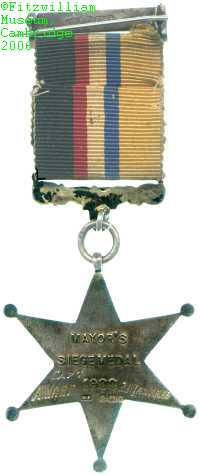
Obverse, the Kimberley town arms and motto in a circle containing the inscription, on a six-pointed star with a ball at each point

Reverse, inscription

Obverse, the Kimberley town arms and motto in a circle containing the inscription, on a six-pointed star with a ball at each point |

Reverse, inscription |
During the 1830s and 1840s several Dutch republics had been established outside the British Cape Colony in South Africa, among which were Transvaal and the Orange Free State, all now in modern South Africa. Transvaal was annexed briefly by the British but its independence re-established in the First Boer War.
In the 1880s however the discovery of vast gold reserves in Transvaal brought large numbers of foreign settlers, largely British, across the border, and an attempted coup at the instigation of Cecil Rhodes in 1895. Military escalation followed, negotiations failed and the two Boer republics, convinced that the British intended annexation, declared war in the Cape Colony in October 1899. The immediate result was the siege of British troops in Ladysmith, Mafeking and Kimberley, while field forces attempting to come to their relief were defeated in several open battles by Boer contingents. Kimberley, the first town to be relieved, could open its gates only in mid-February; Mafeking, famously, had to hold out until May.
Once Kimberley had been relieved, its mayor, H. A. Oliver, decided to show the town's gratitude to the surviving defenders by issuing this star. Although it bears the crown and royal monogram, it is not an official award and could not be worn in uniform; the official award was a bar to the Queen's South Africa Medal. The result is that the Star, rarely worn, is usually in excellent condition, which has made it a frequent target of imitation.
This example is unofficially engraved to Captain A. Ward, of the 21st Lancers. Lester Watson acquired it at some point before 1928.